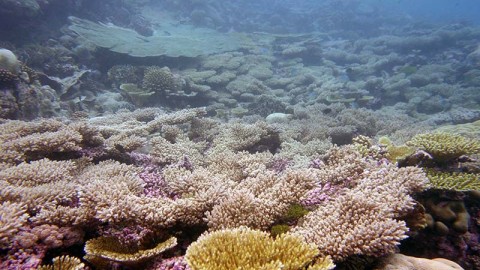BIOT Science Expedition 2014 - Squalling Away - Day 9
Squalling away

Squalls happened today. Frequently and tropically. Swollen seas, gusty winds and torrential downpours were our companions for the day’s activities. Luckily diving involves getting wet anyway so the latter was par for the course but the former two had effect on our plans. Of the two dive parties venturing out this morning the first had to turn back from their Oceanside target site and select an alternative in the shelter of the lagoon. The second dive party negotiated some dominating seas to find their calmer waters on the far Oceanside of an island to the wind. While those beneath explored the watery beauty around the reef, those on safety watch above could see the approaching squalls and watch the gradual arrival of tumultuous curtains of rain before an overcast break between downpours allowed a little drying for soaked bodies.

Despite the less than ideal conditions a full days diving and terrestrial work went ahead. Temperature loggers were recovered and replaced, fish, coral health, coral biodiversity and other surveys were the order of the day, all contributing to the build up of scientific knowledge of the Archipelago. In some respects the weather worked in our favour as we explored new dive sites within the lagoon that proved to be stunning in the richness and health of their corals, and biodiversity and abundance of fish life.

Whilst we all were getting wet diving Pete continued his terrestrial forays.
“Today another two islands were visited, both proposed as IBAs due to their breeding seabirds. The tide was on the rise when we reached the first and we could not navigate the boat over the coral reef fringe surrounding the island. This meant we had to jump over the side of the boat swim-surf over the reef fringe and then walk the remaining distance to the shore; a bracing start to a day of monitoring!

The first of the islands has held over 20,000 breeding pairs of Sooty Tern in previous years though none were present today. The island did hold approximately 1600 pairs of Lesser Noddy and the usual numbers of breeding Red-footed Booby, Common Noddy and Common White-tern. By the time we finished our survey the tide was high enough for the boat to collect us from shore and deliver us to the nearby sister island. This island has spectacular stands of Pisonia grandis trees and these are home to the largest number of breeding Lesser Noddy in the Chagos. Despite some of the veteran trees being blown down in the recent storms, the Lesser Noddy were breeding in all stands and, a new sight for me, in stands of smaller Neisospermia (Ochrasia) oppositifolia on the island too. This extension of breeding range on the island produced the highest count of breeding Lesser Noddy for this island, some 14,000 breeding pairs. Whilst the storms have damaged trees and chicks of tree-nesting seabirds have been lost by being blown out of the nests, other species benefit. On the forest floor large numbers of Coenibita hermit crabs were waiting for their next feed, including the giant among this family, the Coconut Crab. More to follow on this unique omnivore tomorrow, if the expedition plan is unaffected by the weather!”

Jon, our expedition doctor, who accompanied Pete on his island explorations during the day arrived back at the boat early in the afternoon. This allowed him the time to turn his healing skills to the air compressors which fill our scuba tanks. Critical to achieving our underwater aims these need to be kept in tip top condition so the engine surgery kit of spanners, spares and nuts and bolts came out with a few cans of oil and perhaps a little dose of profanity. Duly sworn into wellbeing the compressors did their duty and we’re set for diving in the morning. Fingers crossed we won’t be getting quite so sodden and windswept while not submerged.

